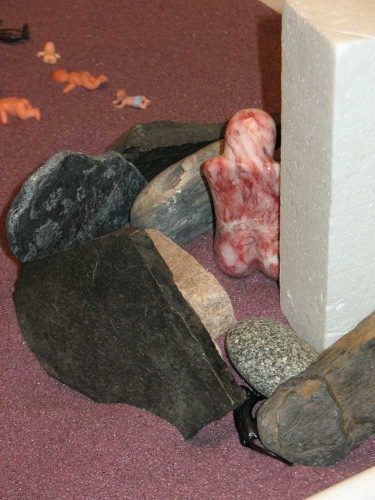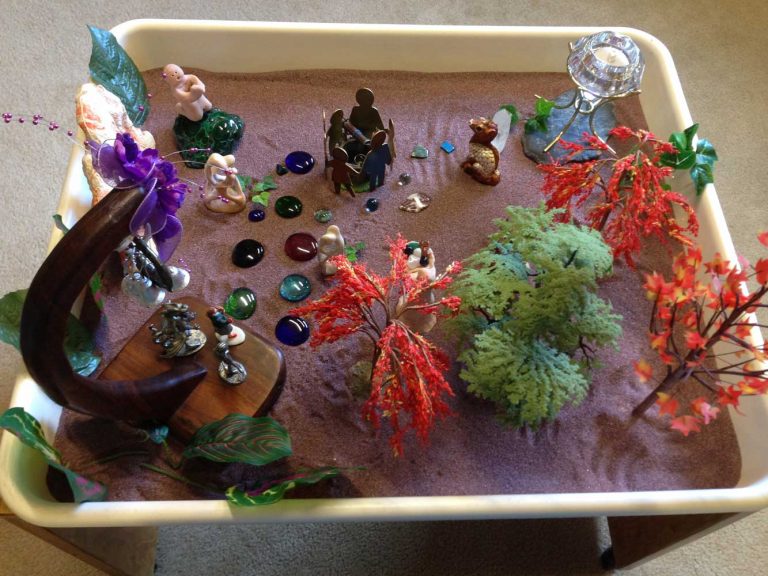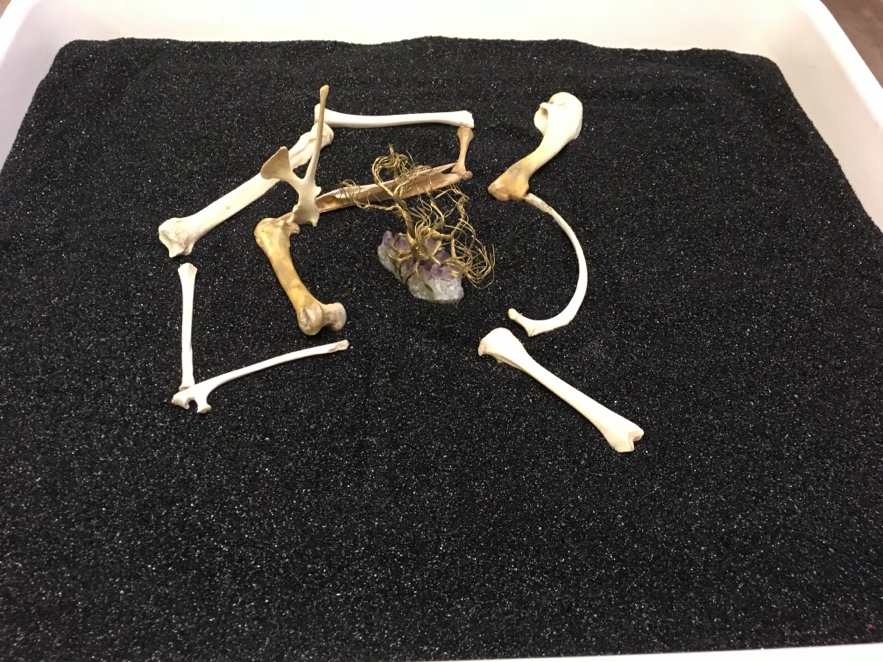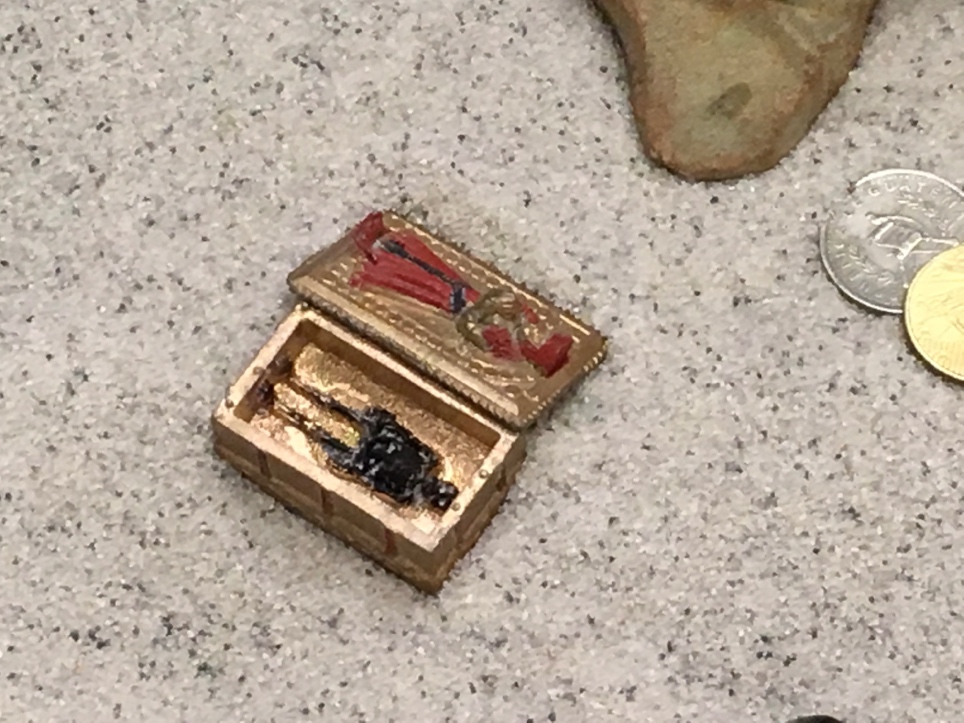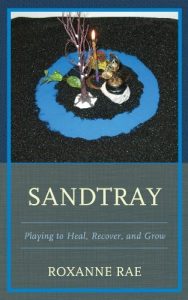For Professionals
This segment of my website is offered to therapists who may be interested in my work and methods. I intend to be responsive to your requests or inquiries about Expressive Arts therapies, particularly Sandtray. I am interested in hearing from you about topics you may want addressed. Please contact me here.
I have been teased for decades about being a Sandtray “pusher.” This may be true as I certainly have found Sandtray to be a powerful approach for people who are able to use it, including myself. This is why I encourage any professional with a bit of curiosity on the subject to give it a try. There are ways to explore the Sandtray process without a large financial commitment. Sandtray is an excellent part of self-care. I invite you to review the comments of several colleagues below. I have included sample photographs from a variety of people.
The Sandtray approach offers these advantages:
- Requires no skill
- Is strength based
- Does not evoke competition or shame from others’ comments about what is made
- Is multisensory: awakens sight, touch, smell, sound, vision, movement, and proprioception
- Evokes implicit memory and/or frame of mind
- Invites creativity, freedom, and flexibility
- Facilitates the integration of physical, intellectual, and emotional experiences to promote a more cohesive sense of self
- Can be a bridge between the explicit and implicit parts of oneself, improving communication
- Taps one’s innate resilience
- Supports self-mastery
- May be both pleasurable and meaningful
Self-care for Therapists
Unaddressed therapist distress places clients in jeopardy. The inherent nature of working with suffering people exposes us to compassion fatigue or vicarious traumatization, risking burnout. Sandtray journeys can make us more effective in the treatment room. Expressive Arts, Sandtray in particular, helps us clarify our own personal and professional issues. The system of symbols that is language tends to be removed from our profound and deeply personal experiences. Nonverbal and less-verbal approaches evoke the less actively available aspect of our mind which dwells in the right hemispheres of our brains, where implicit thought and image reside.
Even when therapists believe that they are consciously addressing countertransference issues, unconscious material continues to be transmitted. When we are feeling stuck with a client or a personal problem, Sandtray work can shed light on issues that we could not identify by intellect alone. I encourage therapists to use Sandtray as a way to bypass a judging intellect. Sandtray affords us a way to “metabolize” our countertransference reactions and to learn to recognize and enhance personal resources. It also offers the opportunity to explore and heal issues that may arise from our own past experiences when they are evoked by clinical work.
Psychotherapy is different from many other professions in that we do not all apply the same set of actions or tools to each client. We do base our services on a body of knowledge and skills. The art of knowing when and how to apply what we have learned is based on our personal interactions with our clients. This therapeutic process deeply engages all aspects of our lives—our perceptions, memories, beliefs, and automatic reactions as human beings, including both what is readily known to us and what is implicit. The more we learn about ourselves and how we function in the world, the more helpful we can become as therapists.
The client /therapist relationship is embedded in a dynamic relational space that is co-created in our moments together. During therapy a client becomes a healthier functioning person within the context of this vital relationship with the therapist. As clinicians, we have the challenge of entering a lived, authentic connection with our clients while maintaining appropriate and reliable boundaries. We use what we know, who we are, and what is in our hearts to aid others to improve their lives. While creating a safe environment for our clients to explore and grow, we share affective states with them, providing both resonance and containment. Not having a script for these functions requires that therapists continually review and develop our own approaches and processes for this work. Sandtray can be helpful in supervision/consultation to increase our capacities for flexibility, tolerance, and self- regulation, and to better honor our clients with compassion, empathy, and respect.
Professional's Comments…
As a trauma play therapist myself, I have sought clinical consultation for issues related to vicarious trauma and self-care from Roxanne. She is a well-respected, trauma informed, clinical consultant and resource for local community agencies, including my own. Roxanne has specialized in Sandtray and Play Therapy for children and adults for decades.
Having engaged in talk therapy in the past, I was moved by the depth of insight in the less-verbal work provided, which cut through my well-established defense mechanisms. With Sandtray, I was able quickly to identify, explore, and resolve my intense reactions to client situations by accessing my subconscious traumatic responses that I had not been able to identify cognitively. With Roxanne as mentor and guide, I felt safe, unconditional positive regard, acceptance, understanding, self-directed and most of all, seen. Sandtray helped me to explore countertransference and my own childhood trauma, deepening my capacity in my own practice, and safeguarding my therapeutic alliance with my clients. As a result of this work, I was able to move through and integrate traumatic experiences, explore and reduce counter transference, increase my reflective capacity and compassion toward myself and my clients, correct cognitive distortions and feel more joy while doing so. Having subsequently obtained instruction in Sandtray by attending one of Roxanne’s trainings, I am now able to integrate this widely utilized modality into my own therapeutic practice.
“I’ve found Sandtray to be an effective way for children to express their thoughts and feelings non-verbally. This process allows them to work through their trauma while finding new ways to deal with their emotional struggles and build resiliency through play. Their creativity and self-expression come through as they choose figures and form their sand worlds.
On a personal note, when I get stuck in my head and talking through issues is not working, Sandtray therapy allows me to tap into my own creativity and see life experiences from a different perspective. The insights and revelations that have come from my Sandtray sessions have astounded me and provided me with deep healing and growth.”
“The Sandtray for my child clients is a platform for them to involve their hands and minds to both ground and express themselves.”
“ Early in my career I was fortunate to have trained with Roxanne. Her Sandtray methods became an integral part of my training through to my DBH and became part of my practice in the delivery of mental health treatment. She introduced me to a process of therapy that provides significant lasting change to areas of the brain that aren’t often achieved with talk based or Cognitive Behavioral Therapies. The application of her Sandtray approach, which integrates object relations, co-regulation and attachment, are formative and essential for clinicians. As the manager of a group practice, I ensure that our therapists are trained in this modality. It is a required feature of their clinical development. I absolutely recommend that you learn these techniques to offer your clients an amazing option when words are not enough.”
“I became immersed in multisensory experiences when creating my Sandtray. Looking, seeing, touching, and moving sand and objects demonstrated to me how my body and mind are one. For me, cognitive mental processes often hamper growth and self-knowledge. My psychological defenses can be successful in making a duality of what is united. The Sandtray holds my personal journey right out in front of me, for me to see, to hold, to build on, or to modify, and use as a reference. My Sandtray is built from a “state-of-being” sensory experience, not from abstract language. Yet, I want to apply language so that I can remember and communicate my deep Sandtray experiences with words.
I believe that the unknown, or unconscious, aspect of my life leaves me in the dark if it remains so. This essential part of me shapes my behavior, my beliefs, my choices, my loves, my anxieties, in short,—everything. It is of utmost importance to me, therefore, that I utilize a therapy approach that can shine light into the darkness, onto my lack of self-knowledge and lack of self-awareness. In this dark area, even the light of a small candle can profoundly diminish my darkness.”
